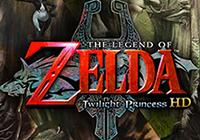The Legend of Zelda: Twilight Princess HD (Wii U) Second Opinion Review
By Jimmy  23.12.2016
23.12.2016

The timing of The Legend of Zelda: Twilight Princess' release can in many ways be considered awkward. It launched alongside the Wii in 2006; the console that would revolutionise the gaming market through motion controls. Twilight Princess was not, however, originally a game made for the Wii; rather, it was originally conceived for and also released on its predecessor, the GameCube. It was a very traditional game, extremely faithful to the legacy the 3D titles the Zelda series had created, but the Wii version had an unnecessary motion control transplantation. This led many to favour the GameCube version, insisting that the Wii version was diluted. Now, ten years later, The Legend of Zelda: Twilight Princess HD is re-released for the Wii U. Does this allow for the game to be fully appreciated, or does it instead remain the black pit of Nintendo's transitional period of the early 00s?
Twilight Princess sees an older Link take centre stage. His trusty steed Epona is available from early on, and it is all very reminiscent of Ocarina of Time. There is, however, some evidence of the series evolving by adding more complexity to the combat. Certain enemies require the player to differentiate between virtual and horizontal slashes, ensuring that the combat doesn't just involve mashing the B button for a few minutes. Another new addition to the combat lies in the Hidden Skills; seven special sword techniques that can be learned from a ghostly figure who, too, has the ability to transform into a wolf. These new techniques open up a plethora of new strategies, as they involve jumping and rolling, and increasing the intensity of enemy encounters. Unfortunately, more advanced moves are not essential for defeating any enemies. It really is up to the player as to how involved in the game they wish to get. With Twilight Princess, you must take it upon yourself to make it exciting.
The Wii U version of Twilight Princess allows the use of the Game Pad or Pro Controller; motion control swordsmanship is now a thing of the past. The controls, for the most part, are flawless. There is never a moment of frustration over inputs not being recognised when using traditional controls. With the GamePad, Nintendo has offered motion controls for the camera and projectile weapons. In the Zelda remakes on the 3DS, this worked like a charm, allowing a level of precision that was unachievable on the N64. With the Wii U having used this approach to motion controls in hits such as Splatoon, it comes as a huge disappointment that in Twilight Princess, they are jittery and almost unusable. It saves a lot of hassle by restricting aiming to the analogue sticks.

The original GC and Wii release saw the sound of Hyrule animated through Dolby Pro Logic II, a simulated surround sound that splits two channels into five. The Wii U release sees and upgrade to LPCM 5.1, a true surround sound experience, and the difference is audible. This adds to the immersion of galloping through the grass of Hyrule Field, standing with your back to a waterfall, and walking past the buskers in the bustling town centre. The sound really shines through in the battles, where an enemy will vanish and reappear somewhere beyond your field of vision; a staple of the Zelda series. Where, in the past, the player would run in circles until the enemy came into view, now one can simply wait for the audio cue and turn in that direction. One may argue that this is much more immersive than the 3D effect found in the 3DS Zelda games.
One major complaint against the Zelda series is that when new items are acquired, they're used in one dungeon alone, only to be forever locked inside Link's bottomless pockets. Twilight Princess is not completely innocent in this regard, but the later dungeons showcase some of the creative puzzle design that have the player searching through their items before they reach that ever so satisfying "ah-ha" moment. This applies to Link's wolf transformation, too, where it must be used in some really unexpected places. It is a real shame that the shield snowboard is only ever used once.

Cubed3 Rating
Great - Silver Award

Twilight Princess HD may have disappointed some, as it didn't receive the same graphical update found in The Wind Waker HD, but while the latter was made to show off the Wii U's HD visuals, Twilight Princess HD seems to want to stay close to original—the GameCube original. Maybe Nintendo itself felt some guilt over slapping on motion controls to the 2006 Wii release, and this is the team's way of atoning for it. Twilight Princess HD attempts to make the definite version of the game with a polished control scheme, superb sound, and graphics cleaned up for HD displays.

![]() 9/10
9/10
![]() 9/10
(2 Votes)
9/10
(2 Votes)
 Out now
Out now  Out now
Out now  Out now
Out now  Out now
Out now Comments
Comments are currently disabled

 Sign In
Sign In Game Details
Game Details Subscribe to this topic
Subscribe to this topic Features
Features






 Top
Top

